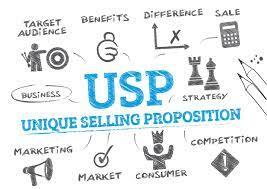Table of contents:
What are Unique Selling Propositions?
A unique selling proposition is a way of separating a brand, product, or service from competitors by communicating a certain distinguishing attribute or factor.

Giving customers a reason to buy from you
Looking at the websites of some of the key players in the retail industry, it’s surprising how many don’t attempt to communicate their proposition on their websites. In today’s highly competitive space, even a brand with a strong reputation cannot assume that they don’t need to give customers a reason to shop with them.
Once establishing that a website is relevant to their task, customers are subconsciously looking for an answer to one key question: “Why should I stick around?”. It’s unlikely that they’ll go looking for the answer. By clearly communicating your unique selling proposition and key differentiators, you give customers the confidence and assurance they need as they move through your website. The homepage is an obvious place to start, but make sure you review your analytics to assess where the majority of your customers land, to ensure that this key information is not missed by those who land elsewhere.
Getting the message right
It’s likely you operate in a very competitive market where they are numerous other companies offering a very similar product or service to you. The key with any unique selling proposition is the unique part. Although the word ‘selling’ may seem off putting or irrelevant if your website isn’t transactional, the theory still stands. No matter the type of website, communicating what is unique about it can be the difference between a conversion for you and a conversion for a competitor.
Marks & Spencer use the space under their navigation bar to promote offers as opposed to proposition or differentiator messaging. By browsing their information pages I found that they offer next day store collection, free delivery over £50, they have 700+ stores in the UK and have been operating since 1884. A quick browse of their products and it is clear there are a lot of positive customer reviews. These points could make powerful messages if incorporated into any of the methods listed below, yet I had to search for this information. It is unlikely that the average user would do the same.
3 Ways to Communicate Your Unique Selling Propositions Effectively
This is fast becoming the norm, especially on retail sites. Implementing a bar that sits directly under the main navigation creates an area of prime page real estate which can be used to display differentiators. The popularity of the USP bar means users are becoming accustom to seeing information displayed in this way: this means its implementation should not have a negative impact on returning customers. This method creates space for multiple USP messages, which can incorporate persuasive techniques such as social proof and authority. Icons are also widely used in USP bars to help reduce the visual impact of large amounts of text. USP bar messaging and ordering can make for a very valuable A/B test.
2. Use a tagline
Using a tagline is an effective way of succinctly communicating your key brand proposition and values. Taglines increase brand recognition when they’re used consistently online, in store and across advertising. Coming up with a tagline to represent the entirety of a brand is not an easy job and not something that can be implemented without senior buy-in. As well as understanding your market, user research can really help to uncover what your brand stands for at what resonates with your customers. Testing it can then validate your chosen tagline by seeing whether it is something that has an impact.
3. Add a dedicated block of USPs
If you have a lot to shout about, a dedicated block on your homepage can be used to communicate all reasons customers should choose to shop with you. As the block would not be displayed across multiple pages, this method is best if the majority of your customers land on your homepage. The position, size, style and messaging should again be tested to find what works best in terms of increasing your overall conversion rate. Although analytics or testing tools may show little user interaction with this sort of content, this doesn’t mean the presence of the block is not having a positive impact on your key conversion metrics.
Summary
Each of these methods presents a number of different opportunities for learning through research and testing. Similarly, the three techniques could be tested against each other to find the version that resonates best with your customers and has a positive impact on their buying behaviour. Whatever you choose, remember the importance of giving your users a reason to choose to use you over competitors from their first interaction with your website.
Questions
- Have you identified areas in your customer journey where the addition of USP have improved conversion rates?
- What’s your businesses USP and how did you go about developing it?







